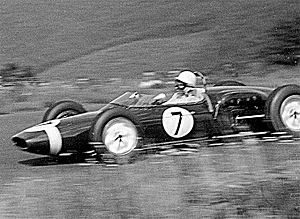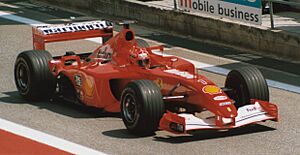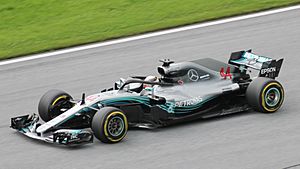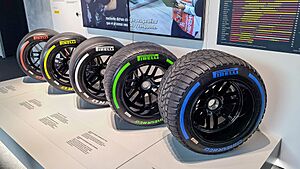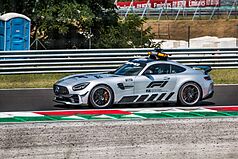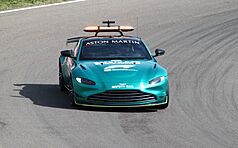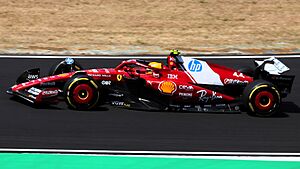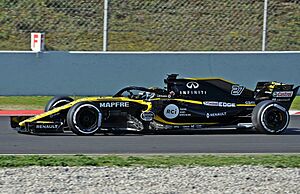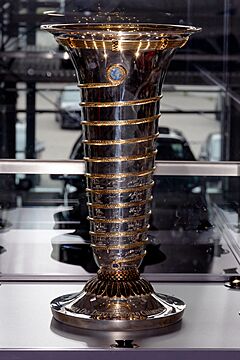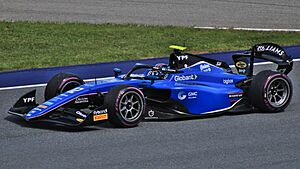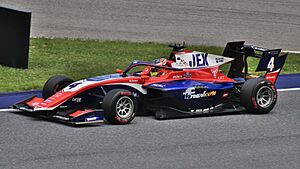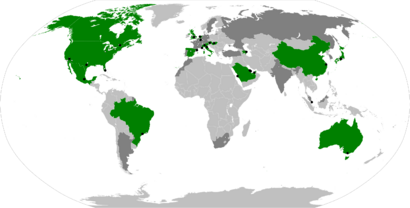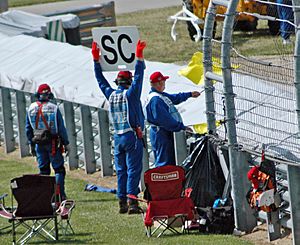Formula One facts for kids

Formula One logo since 2018
|
|
| Category | Open-wheel single-seater Formula auto racing |
|---|---|
| Country | International |
| Inaugural season | 1950 |
| Drivers | 20 |
| Teams | 10 |
| Engine manufacturers | |
| Tyre suppliers | Pirelli |
| Drivers' champion | (Red Bull Racing-Honda RBPT) |
| Constructors' champion | |
Formula One (F1) is the top level of car racing in the world. It features special open-wheel single-seater cars. The Fédération Internationale de l'Automobile (FIA) sets the rules for these exciting races. The FIA Formula One World Championship started in 1950. Many people see it as the most important motorsport event.
The word formula means a special set of rules that all cars must follow. A Formula One season has many races called Grands Prix. These races happen in different countries on special tracks or closed public roads.
Drivers earn points in each Grand Prix. These points help decide two yearly champions: one for the drivers and one for the teams (called constructors). To race, drivers need a special Super Licence. Tracks must also meet high safety standards.
Formula One cars are incredibly fast. They use aerodynamics to stick to the track, especially with their wings and underbody tunnels. This helps them take corners at very high speeds. The cars rely on advanced electronics, suspension, and special tyres. Some electronic driving aids, like traction control, were banned to make racing more about driver skill.
Running a Formula One team costs a lot of money. Teams design, build, and maintain cars, pay staff, and handle transport. The Formula One Group manages the sport. It is owned by Liberty Media. Many Formula One teams are based in the United Kingdom.
Contents
Formula One History
Formula One racing has a rich history. It grew from earlier championships like the World Manufacturers' Championship. The "formula" part means a special set of rules for the cars. These rules were agreed upon in 1946 and started in 1947. The first official World Championship race was in 1950.
The very first World Championship race happened on May 13, 1950. It was the 1950 British Grand Prix at Silverstone Circuit in the UK. Giuseppe Farina won the first Drivers' World Championship for Alfa Romeo. Another legend, Juan Manuel Fangio, won five championships in the 1950s. This record stood for 46 years!
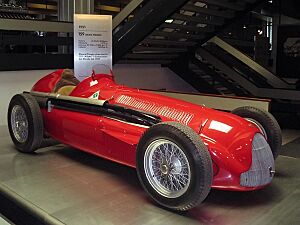
In 1958, a championship for the teams, called the Constructors' Championship, was added. Famous driver Stirling Moss raced in this era. He is remembered as one of the best, even though he never won the championship. Fangio had an amazing winning record, winning 24 out of 52 races.
For many years, there were also Formula One races that were not part of the World Championship. These races helped local drivers and cars compete. However, as the sport became more expensive, these extra races became less common. The last non-championship Formula One race was in 1983.
Big Changes in Technology
One big change was when Bugatti introduced cars with engines in the middle. Driver Jack Brabham showed how much better these cars were. By 1961, all teams used mid-engined cars.
In 1962, Lotus brought in a new car design. It used a strong, light aluminum body called a monocoque chassis. This was a huge step forward in car design.
In 1968, teams started putting company logos on their cars. This was called sponsorship. It helped teams get more money. Soon, cars also started using aerofoils, which are like wings. These wings helped push the cars down onto the track, making them faster in corners. This effect, called downforce, became very important.
Later, in the 1970s, Lotus introduced "ground-effect" aerodynamics. This created even more downforce, making cars incredibly fast in corners. The cars needed very stiff suspension because of this.
Formula One Becomes a Big Business
In the 1970s, Bernie Ecclestone helped change Formula One into a huge global business. He helped teams work together to get better deals from race tracks. This made the sport much more profitable.
There were some disagreements between the teams and the sport's governing body (FISA) over money and rules. These were settled with agreements called the Concorde Agreement. These agreements helped make the rules stable for teams.
In the 1980s, turbocharged engines became very powerful. They made cars incredibly fast. To slow them down, rules were made to limit fuel and boost pressure. Turbocharged engines were completely banned in 1989.
Electronic driving aids, like active suspension and traction control, also started to appear. These helped drivers a lot. But in 1994, many of these aids were banned. The goal was to make driver skill more important than technology.
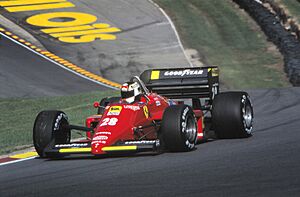
The rivalry between Ayrton Senna and Alain Prost was a big focus in the late 1980s and early 1990s. Sadly, Senna died in an accident at the 1994 San Marino Grand Prix. Another driver, Roland Ratzenberger, also died that weekend. These events led to many new safety rules in Formula One. For example, cars were made narrower, and grooved tyres were introduced to reduce grip and speed.
After these tragedies, no driver died from injuries in a Formula One car for 20 years. Then, in 2014, Jules Bianchi had a serious crash at the 2014 Japanese Grand Prix. He died from his injuries nine months later. This led to even more safety improvements, like the Virtual Safety Car.
Manufacturers Return and New Eras
Michael Schumacher and Ferrari had an amazing run in the early 2000s. Schumacher won five championships in a row, setting many new records. Fernando Alonso ended Schumacher's streak in 2005, becoming the youngest champion at the time.
During this time, the FIA often changed rules to make races more exciting and reduce costs. For example, "team orders" (where teams tell drivers to let others pass) were banned for a while. There were also changes to qualifying and how long engines and tyres had to last.
Around 2008-2009, some big car manufacturers like Honda, BMW, and Toyota left Formula One due to economic problems. This led to some teams being bought by private owners, like Brawn GP (formerly Honda) and Lotus F1 Team (formerly Renault).
A big change came in 2014 with new engine rules. Cars switched from V8 engines to smaller, turbocharged V6 hybrid power units. Mercedes became very dominant, with Lewis Hamilton winning many championships. Other teams like Red Bull Racing and Ferrari also fought for titles.
This era saw more car manufacturers join the sport again. Honda returned, and Renault bought back its team. Brands like Aston Martin and Alfa Romeo also became involved. In 2020, all teams signed a new agreement that included a budget cap. This cap limits how much money teams can spend on car development. It helps make the competition fairer and more sustainable.
The COVID-19 pandemic caused delays and changes to the racing seasons in 2020 and 2021. Many races happened without fans. New car rules, meant for 2021, were moved to 2022. These rules aimed to make racing closer and more exciting.
In 2022, major rule changes brought back ground effects and introduced new aerodynamics and larger wheels. Red Bull and Max Verstappen became the dominant team and driver in 2022 and 2023.
In 2024, some teams changed their names due to new sponsors. For example, Scuderia AlphaTauri became Visa Cash App RB. Formula One also partnered with toy companies like Mattel (Hot Wheels) and Lego to create new products.
Racing and Strategy
A Formula One Grand Prix event takes place over a weekend. It usually starts with practice sessions on Friday and Saturday. These sessions help drivers get used to the track and test their cars. After practice, there's a qualifying session to decide the starting order for Sunday's main race.
Tyre Rules
Drivers get a certain number of different types of tyres for each race weekend. There are dry-weather tyres (called slicks), intermediate tyres for light rain, and wet-weather tyres for heavy rain. Unused tyres must be returned.
Qualifying for the Race
Qualifying decides who starts where on the grid for the main race. The current system is called "knock-out" qualifying and has three parts: Q1, Q2, and Q3.
- Q1: Lasts 18 minutes. The slowest five drivers are eliminated.
- Q2: Lasts 15 minutes. The 15 remaining drivers try to set one of the ten fastest times. The slowest five are eliminated.
- Q3: Lasts 12 minutes. The final ten drivers compete for the top ten starting positions, including pole position (first place).
Drivers can do as many laps as they want in each part. If a driver's best lap in Q1 is too slow (more than 107% of the fastest time), they might not be allowed to start the race.
Sprint Races
Since 2021, some race weekends have included a 'sprint' race on Saturday. These are shorter races. From 2023, sprint races have their own qualifying session, called the 'sprint shootout'. The results of the sprint race do not affect the starting order for Sunday's main Grand Prix.
The Main Race
The race begins with a warm-up lap, called the formation lap. Drivers use this to check the track and warm up their tyres. Then, they line up on the starting grid.
Five red lights light up one by one. When they all go out, the race begins! If there's a problem, like a stalled car, the start can be stopped. Sometimes, if it's very rainy, the race might start behind a Safety Car.
During the race, drivers can make pit stops. This is where they quickly enter the pit lane to change tyres or fix small damages. Drivers must make at least one pit stop and use two different types of dry tyres during a race.
The race usually ends when the leader finishes a set number of laps. If conditions become too dangerous, the race can be paused or ended early.
Race Director's Role
The race director manages each Grand Prix. They make sure rules are followed and control the start lights. They can also send incidents to race stewards, who might give penalties for breaking rules. As of the 2024 Las Vegas Grand Prix, Rui Marques is the race director.
Safety Car
If there's an accident or danger on the track, a safety car is deployed. Drivers must follow it at a reduced speed, and no overtaking is allowed. This helps keep everyone safe while the track is cleared. Once the danger is gone, the safety car leaves, and the race restarts.
Mercedes-Benz has provided safety cars since 1996. Since 2021, Aston Martin also supplies safety cars. The main safety car driver is Bernd Mayländer.
Virtual Safety Car
In 2014, after a serious crash involving Jules Bianchi, a new safety measure was introduced: the Virtual Safety Car (VSC). When the VSC is active, drivers must slow down and keep their lap times above a certain minimum. This helps manage dangerous situations without needing a physical safety car on track.
Racing Flags
Flags are used to communicate important messages to drivers during a race.
Points System
Points are awarded to the top ten drivers in each race. The winner gets 25 points. These points add up throughout the season to decide the World Drivers' Champion and World Constructors' Champion.
| 1st | 2nd | 3rd | 4th | 5th | 6th | 7th | 8th | 9th | 10th |
|---|---|---|---|---|---|---|---|---|---|
| 25 | 18 | 15 | 12 | 10 | 8 | 6 | 4 | 2 | 1 |
To get points, a driver must complete at least 90% of the race distance. This means they can still get points even if they don't finish the very last lap.
Constructors
A Formula One constructor is the company that designs the car's main body (chassis) and engine. If one company makes both, like Ferrari, they get all the credit. If different companies make them, both are named (e.g., McLaren-Mercedes).
Teams must build their own chassis. This makes Formula One different from other racing series where teams can buy chassis from others. Entering a new team in Formula One costs a lot of money, which helps support the existing teams.
Most Formula One teams have their main base in England, in an area known as "Motorsport Valley." Ferrari is unique, with both its chassis and engine made in Italy. Other teams like Racing Bulls and Sauber have bases in other countries but often have facilities in the UK too.
Drivers
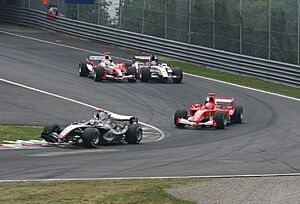
Every Formula One team must have two cars in each race session. They can use up to four drivers in a season. Sometimes, extra drivers (called reserve drivers) participate in practice sessions. They help test the car and might become future F1 drivers.
Drivers need a special FIA Super Licence to compete. This license is given to drivers who have done well in junior racing series and have driven an F1 car for a certain distance. Reserve drivers often practice on simulators to help develop the car.
Each driver chooses a unique number from 2 to 99. They keep this number throughout their time in F1. The number 1 is reserved for the reigning World Champion, who can choose to use it or keep their own number. The number 17 was retired after the death of Jules Bianchi.
As of 2024, 34 different drivers have won the World Drivers' Championship. Michael Schumacher and Lewis Hamilton hold the record with seven titles each. Jochen Rindt is the only driver to win the championship after he died in an accident during the season. Drivers from the United Kingdom have been the most successful, with 20 championships among 10 drivers.
Physical Demands of Driving
Driving a Formula One car is extremely tough physically. Drivers can burn around 1,000 calories per hour and lose several pounds of weight during a race. This is because of the intense g-forces they experience. When cornering, drivers can feel forces up to 6.5 times their body weight! Braking and accelerating also create strong forces.
The cockpit of an F1 car can get very hot, sometimes up to 60°C (140°F). Drivers wear several layers of fireproof clothing. The steering wheel and brake pedal also require a lot of strength to operate. Drivers need to be light, but the FIA sets a minimum weight limit of 82 kg (181 lb) for their well-being. They also need excellent cardiovascular fitness, as their heart rates can be very high during a race.
Path to Formula One
Most F1 drivers start racing in kart racing when they are young. Then, they move up through different single-seater racing series in Europe, like Formula Ford, Formula Renault, and Formula 4. After that, they often compete in higher-level championships like Formula Three and then the FIA Formula 2 Championship (F2), which is the highest step before F1.
Drivers don't always have to go through every single step. For example, Max Verstappen joined F1 after just one season in European F3. Some drivers, like Kimi Räikkönen, even jumped straight from Formula Renault to F1.
Grands Prix
The number of races in a Formula One season has changed over the years. The first World Championship season in 1950 had only seven races. The 2024 season had 24 races, which is the most ever in one season.
Most of the early races were in Europe. Over time, Formula One expanded to other parts of the world. The first South American Grand Prix was in Argentina in 1953. The first African Grand Prix was in Morocco in 1958. Asia and Oceania followed, and the Middle East hosted its first race in 2004.
The British Grand Prix and Italian Grand Prix are the only races that have been held in every Formula One season. The Monaco Grand Prix is also very famous and has been running almost continuously since 1955.
Most Grands Prix have traditionally been held during the day. However, the 2008 Singapore Grand Prix was the first Formula One night race. Other races, like the Abu Dhabi Grand Prix and Bahrain Grand Prix, also became night races.
Contracted Grands Prix
The following twenty-four Grands Prix have a contract to be hosted at the listed circuits for the 2026 season:
- The Emilia Romagna Grand Prix is contracted for 2025, but does not have a contract for 2026.
Circuits
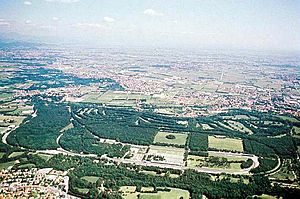
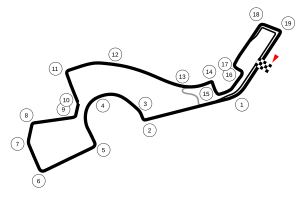
Formula One races are held on special tracks called Grade A tracks. These are the highest-rated tracks by the FIA. Tracks can have different layouts and lengths. However, most Grands Prix must cover a total race distance of about 300 to 305 kilometers (186 to 190 miles). The Monaco Grand Prix is a bit shorter.
A typical circuit has a long straight section for the starting grid. Next to it is the pit lane, where teams have their garages. During a pit stop, drivers enter the pit lane to change tyres, get repairs, or make adjustments. Before 2010, cars also refueled during pit stops.
Most F1 tracks are built just for racing. But some races happen on converted public streets, like in Monaco, Singapore, and Las Vegas. Three-time World Champion Nelson Piquet once said racing in Monaco was "like riding a bicycle around your living room" because it's so tight!
Circuit design focuses a lot on driver safety. Newer tracks, often designed by Hermann Tilke, have modern safety features. While some people miss the character of older tracks, these new designs meet today's high safety standards.
Many new tracks have joined the F1 calendar over the years. The Circuit of the Americas in Austin, Texas, and the Baku City Circuit in Azerbaijan are examples. In 2023, the Las Vegas Grand Prix also joined the series.
Cars and Technology
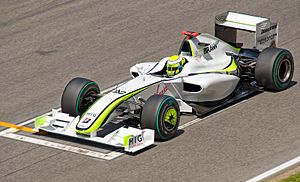
Modern Formula One cars are amazing machines. They have their engine in the middle, an open cockpit, and open wheels. The car's body (chassis) is made from carbon-fibre composites. This makes it very light, but also incredibly strong and safe. The entire car, including the driver, weighs only 800 kg (1,764 lb).
The car's speed in corners comes from aerodynamic downforce. This force pushes the car down onto the track. It's created by the wings at the front and back, and by the "ground effect" from the car's flat bottom. At full speed, the downforce can be 2.5 times the car's weight! This allows cars to take corners with forces up to 3.5 times the force of gravity.
Tyres are also very important for cornering speed. Since 2009, Formula One cars use "slicks" (tyres with no grooves) for dry conditions. These are supplied exclusively by Pirelli. The wheels are made of special magnesium alloys to be light and strong. Since 2022, cars have larger 18-inch wheels with wheel covers.
F1 cars use double wishbone suspension, which helps keep the tyres on the ground. They also have special Carbon-carbon disc brakes. These brakes are very light and work incredibly well even when extremely hot. They have thousands of tiny holes to keep them cool.
In 2022, new rules changed car designs to make racing closer. These changes included redesigned wings, larger wheels, and the return of ground effect downforce. The goal was to reduce "dirty air" (the disturbed air behind a car) so cars could follow each other more closely.
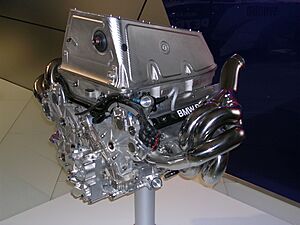
Since 2014, F1 cars use 1.6-litre turbocharged V6 hybrid power units. These engines use unleaded fuel, similar to regular petrol. They also get a lot of power from electric motors and use energy recovery technology. Older engines used to spin at very high speeds, but rules now limit this.
Even with rules that ban some advanced technologies, modern F1 cars are incredibly fast. They can reach speeds over 350 km/h (217 mph) on some tracks. The highest speed ever recorded in a Grand Prix was 372.6 km/h (231.5 mph) by Juan Pablo Montoya in 2005.
Teams are limited to two cars per race. Each driver can use only a few engines and gearboxes per season. If they use more, they get penalties.
Revenue and Profits
Running a Formula One team is very expensive. In 2006, some major teams spent hundreds of millions of dollars on engines alone. The estimated cost to run a team in 2018 was around £193 million (about $240 million).
Formula One teams pay entry fees to the FIA. Drivers also pay a fee for their special racing license.
There have been discussions about how money is shared among the teams. Smaller teams sometimes feel that the bigger, more established teams get a larger share of the profits.
Building a new permanent race track can cost hundreds of millions of dollars. For example, the Shanghai International Circuit cost over $300 million. Converting public roads into a temporary circuit is usually less expensive.
In 2020, due to the COVID-19 pandemic, Formula One reported a loss in revenue because races were delayed.
Cost Cap
For many years, there were no limits on how much teams could spend. This meant wealthier teams often performed much better. For example, in 2019, the top team, Mercedes, spent $420 million, while smaller teams spent much less.
To make the competition fairer, the FIA introduced a cost cap of $175 million in 2021. This was later reduced to $145 million due to the pandemic. It fell further to $140 million in 2022 and is set at $135 million for the next three years.
Some people worried that the cap might not be enough to close the gap between teams, as it doesn't include all expenses like driver salaries. However, the cost cap seems to have helped teams become more efficient and creative. For example, McLaren started the 2023 season as one of the slowest cars but became one of the fastest by the end of the year. In 2024, they won the Constructors' Championship.
Future of Formula One
The high costs of Formula One have led the FIA and Formula One Commission to create new rules to make it more affordable for teams.
After buying the commercial rights in 2017, Liberty Media shared its plans for Formula One's future. These plans focus on making the sport more cost-effective, keeping it relevant to regular cars, and encouraging new manufacturers to join and be competitive. In 2020, all teams signed a new agreement that changed how prize money and TV revenue are shared.
Environmental Impact
Formula One has a plan to become carbon neutral by 2030. By 2025, all events aim to be "sustainable." This means getting rid of single-use plastics and making sure all waste is reused, recycled, or composted.
A report in 2019 showed that most of Formula One's carbon emissions came from logistics (like transporting cars and equipment), not from the race cars themselves.
Since 2021, all F1 cars use fuel with more bio-components. The FIA is also developing a 100% sustainable fuel to be used in Formula One from 2026.
Social Inequities and Diversity
Before the 2020 season, F1 launched the #WeRaceAsOne initiative. This program aims to fight racism and promote diversity in the sport. It includes visible displays of support at races and a task force to improve diversity at all levels of Formula One.
Historically, Formula One has been dominated by European and white drivers. Lewis Hamilton is the first and only black driver to compete in the World Championship.
Teams like Mercedes-AMG Petronas F1 Team have also taken action. They found that most of their workforce was white. To change this, they used a black car livery to promote anti-racism messages and started a program called Accelerate 25. This program aims for 25% of new hires to come from underrepresented groups by 2025.
Drivers have also shown their support. In 2020, all twenty drivers wore "End Racism" shirts and took part in an anti-racism protest before a race.
Women in Formula One
Since Formula One started in 1950, five women have competed in a Grand Prix. Only one of them scored points. However, women are involved in many roles in the sport, including team principals, race engineers, and strategists. The Netflix show Drive to Survive has helped increase female viewership of the series.
Female Drivers
Maria Teresa de Filippis was the first woman to race in F1 in 1958. She is seen as a pioneer for women in motorsport.
Lella Lombardi is the only woman to score points in a Formula One Grand Prix. She finished sixth in the 1975 Spanish Grand Prix, earning 0.5 points.
Desiré Wilson is the only woman to win any kind of Formula One race, winning a round of the 1980 British Formula One Championship.
Giovanna Amati was the last female driver to try to qualify for an F1 Grand Prix in 1992. She faced challenges with an underperforming car and limited testing.
In 2022, Formula One created F1 Academy. This is a racing championship just for women. It aims to inspire the next generation of female drivers. Its first champion was Marta García. The F1 Academy has attracted a lot of attention and sponsors.
Women in Team Roles
Monisha Kaltenborn became the first female Team Principal in Formula One for Sauber in 2010. Claire Williams also managed a Formula One team as Deputy Team Principal for Williams Racing.
Hannah Schmitz is currently the principal strategy engineer at Red Bull Racing. She has played a key role in the team's victories in recent years. In 2023, she won an award for Female Engineer of the Year.
Beginning in 2025, Laura Müller is serving as the race engineer for Esteban Ocon at Haas. She is the first woman to hold this role full-time.
Media Coverage
Formula One is broadcast in almost every country and has a huge global TV audience. All broadcasters receive the same video feed from Formula One Management.
In 1996, an enhanced package called F1 Digital+ was launched. It offered live broadcasts of all sessions and extra camera views. However, it was not financially successful and ended in 2002.
The official Formula One website and app provide live timing and commentary during races. In 2017, Formula One unveiled a new logo. In 2018, F1 launched F1 TV, a streaming service that lets viewers watch multiple video feeds. In 2024, a free streaming channel, the Formula 1 Channel, launched in the United States, showing classic races and documentaries.
Television Broadcasters
In the United Kingdom, Sky Sports F1 broadcasts all races live. Channel 4 also held free-to-air rights until 2018.
In the United States, ESPN has held the broadcast rights since 2013, using the commentary from Sky Sports UK.
In countries like Germany, Austria, Italy, and Switzerland, Sky Sport holds the exclusive rights.
See also
 In Spanish: Fórmula 1 para niños
In Spanish: Fórmula 1 para niños
- Formula One video games
- Go-kart
- DHL Fastest Lap Award
- DHL Fastest Pit Stop Award
- FIA Pole Trophy
- Overtake Award
- Lorenzo Bandini Trophy


